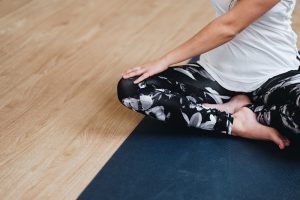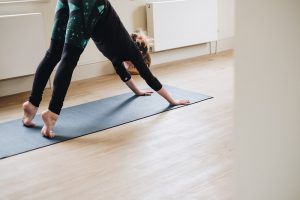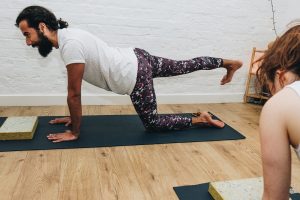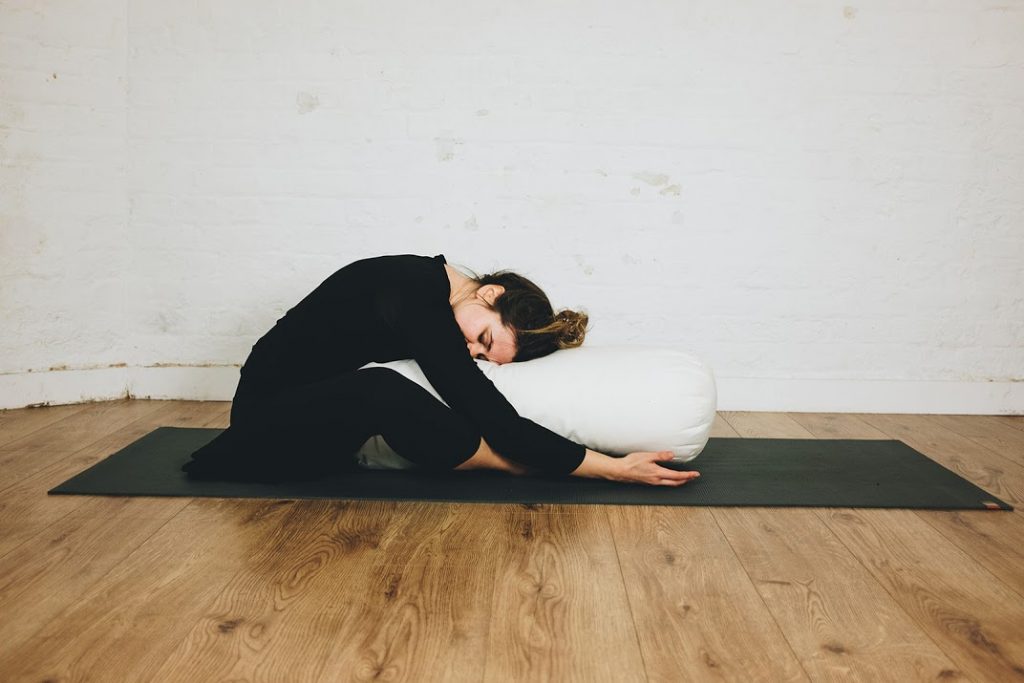A couple of years ago I made the choice to stop posting pictures of myself in aesthetically complex asana on my personal Instagram. These images, pretty as they may be, did not do justice to my practice, my teaching, or my understanding of yoga as a whole. They were, and remain, just one (small) part of it.
I didn’t stop posting yoga-related content on my grid; instead, I challenged myself to more fully represent what yoga is for me, in terms of how it feels –– within and beyond asana.
These intentions also underpin Nourish’s Instagram. However, as a yoga business, there is an even greater responsibility, as well as challenge, to provide a more diverse and holistic representation of yoga. Nourish’s ‘look’ needs to align with the multifaceted content of our 200-hour, Pregnancy, Inclusive Yoga Trainings, and workshops. In turn, this ‘look’ must, in some way, represent yoga, in its richness and complexity.

I have reflected long and hard about what words, ideas, and feelings can do justice to the depth and breadth of yoga, and how to translate these into images. One concept I come back to over and over, particularly when contemplating asana, is Embodiment.
Embodiment encompasses the inner world of asana, as opposed to just the external form of the pose. An embodied asana practice also asks us to redefine not just how we feel and experience our practices but how we connect with our yoga practice, our bodies and complex selves, as well as how we communicate and teach asana from a place of embodiment.
Embodied asana shifts the emphasis of our practice and links it fluidly to other aspects of yoga, our lives, and general state of being in the world. Through embodied asana I find the seamless connection between the inner and outer.
Embodied asana not only transforms how we practice, but it is a feeling that can be harnessed for how we communicate –– verbally and visually –– yoga. This blog unpacks these implications of embodied asana, traversing everything from practical advice for practising and teaching to cultural critique. Understanding the impact of an embodied practice helps inform larger, critical, conversations about yoga.
Alignment for Embodied Asana
‘Often in a yoga class, the cues given by the teacher focus on the shape of the pose rather than the intention of the pose… When a teacher, or the student herself, starts to judge the pose by what it looks like rather than what it feels like, then the intention of optimizing health is lost.’
This quote sums up yoga educator Bernie Clark’s approach to choosing functional alignment over the external aesthetic shape of the pose. A functional approach to alignment –– alignment itself being a much-misunderstood topic –– is foundational for approaching asana as embodied.
Understanding Alignment
The Merriam-Webster Dictionary defines alignment as ‘the proper positioning or state of adjustment of parts […] in relation to each other’.
This definition isn’t strictly bio-mechanical, which is how the concept of alignment is intended in a yoga class. However, the practice of adjusting and positioning parts of ourself, all in relation to each other, speaks to much of what is true for alignment in yoga.
Relation – what we choose to do with one part of our body must make sense within the complete context of the body. Our singularly unique bodies.
Anatomically, from our joint structures to skeletal and muscular tissues, we are all individuals. Therefore, we need ways of teaching asana that can accommodate everybody’s unique anatomical requirements.

Most often, we are instructed into asana via the arrangement of our external physical form, which can cause us to end up in anatomically un-harmonious relationships. For example, in many asanas –– such as tadasana, trikonasana, downward dog –– we are told to have our hips, knees and ankles stacked or in one line, with the toes pointing forward. The reality is that, depending on the complex hip structures, people may be torquing their knees or ankles in their effort to get their toes pointing forward.
We tend to emphasise the external form (i.e. what we look like) because this is the part of the body we can see. But alignment starts with the musculoskeletal system; a nuanced approach to our interior mechanics means the outward look of the pose will vary for everybody. However, everybody will also be experiencing, or moving towards, their version of internal integration.
Experiencing Asana as Embodied
Embodied asana often incorporates functional alignment. However, embodied asana entails taking cues from the entire self, which means it doesn’t require asana to always, or solely, be physically functional.
An embodied approach incorporates alignment as something which can be supportive in the broader context of the self –– emotionally, psychologically, perhaps spiritually. In this sense alignment can be holistic, supporting us on more than just physical planes.
An understanding of biomechanics and functional alignment is undoubtedly helpful for taking an embodied approach to asana. However, there is also a more intuitive approach. You can listen and feel into your body.
Embodied asana rests on the ability to take your cues from within the body. The external form of the pose can become a response to internal sensations and dynamics.
Ask yourself what the dynamics and intention of the pose are? Where is there stability, rotation, lengthening, opening, strength, softening or ease? Then ask yourself what you need from your pose or practice –– discipline, release, support, hip opening, to cry? These will all determine how you adjust your practice to best serve yourself.
I believe embodied asana is simple and approachable. However, your practice may not end up looking different from what you usually see. This can create an internal rupture as we tend to evaluate our asana practice by certain external expectations. For this reason, taking an embodied approach to asana grows more significant as it creates pushback against some of the more toxic and troubling aspects of contemporary yoga.
Embodied Asana Challenges What Yoga Should Look Like
Yoga has become highly aestheticised, and increasingly outward-looking. We have come to know yoga by the uniform images of asana, favouring visual form over function, which proliferate on social media and adverts. These are not just synonymous with athleticism but –– as a recent academic paper analysing the visual representation of yoga in major yoga publications demonstrates –– whiteness, the west and women.
 Not only does this mean yoga is being visually represented in society’s dominant patriarchal, imbalanced, and detrimentally capitalistic infrastructure, but these images often perpetuate the commodification and cultural appropriation so ubiquitous in contemporary yoga. Many of Nourish’s offerings, such as our scholarships, which I have written about here and the much needed expansion of ideas around pregnancy, are about finding ways to oppose this trend and reimagine the current landscape of yoga culture enmeshed within society at large in more inclusive and respectful terms.
Not only does this mean yoga is being visually represented in society’s dominant patriarchal, imbalanced, and detrimentally capitalistic infrastructure, but these images often perpetuate the commodification and cultural appropriation so ubiquitous in contemporary yoga. Many of Nourish’s offerings, such as our scholarships, which I have written about here and the much needed expansion of ideas around pregnancy, are about finding ways to oppose this trend and reimagine the current landscape of yoga culture enmeshed within society at large in more inclusive and respectful terms.
How we teach and understand asana has come to reflect this particular ‘look’ of yoga, a look so many of us engage in when we share or like images of yoga on social media. The visuality of contemporary yoga is significant, and it is one of the topics Mathew Remski addresses in his webinar lecture series, in breaking down the diverse detrimental impacts of photography in modern yoga. Remski also ties this to the shift from yoga as an oral tradition to a visual one.
Consequently, we need to re-evaluate how we practise and share –– on social media and in-class –– yoga more generally, and asana specifically. An embodied approach is not only more inclusive, safer and accurate, in the visual representation of yoga asana, but it also challenges how we approach, think of, and see yoga.
How to Practise Embodied Asana
Practising embodied asana may not feel natural at first, as many of us haven’t been taught with this approach. However, these are some of my favourite ways to invite embodiment in:
Feel Your Way In
Freeform and less structured movement are great gateways into sensorily experiencing the body in movement. Rolling, crawling, swaying, wriggling, stillness. Let your body, as opposed to mind, guide you towards shapes and movements that feel welcome or natural.
Explore Your Asana
Start in a pose you know well, and then modify it. Change the width, position and angle of your arms, legs, head and torso. Notice how this shifts the sensations; see if you can move towards the entire body being in a supportive relationship. I recommend using props, including walls for this.
Use Functional Alignment Cues
Strip a pose back to its functional intention. For example, where in the body are you looking for opening, strengthening, rotation, lightness, groundedness, support, lift, contraction, engagement, restriction… How can you balance the different dynamics?
For example, downward dog encourages lengthening through the back of the body and strengthening through the front, as well as shoulder stability balanced with the movement of weight back into the legs. If you start with these intentions, you might find it doesn’t matter how far apart the arms or legs are, or what direction the hand and feet point, or how straight the legs are. However, the hips will naturally rise, as the back and hamstrings lengthen.
Embodied Asana As Mindfulness
Mindfulness is often defined as moment-to-moment awareness of our experience, without judgment… which goes hand-in-hand with embodied asana, as a practice grounded in experiencing the body and sensations. Externally motivated alignment often encourages a lot of thinking and analysis as we try to replicate a particular form, and the experience of how we feel is questioned, critiqued and generally subjugated to the mind. Embodied alignment emphasises the exploration of feeling and moving towards the most compassionate and welcoming physical form.
Teaching Embodied Asana
How you choose to practise yoga is a deeply personal choice.
However, if you teach yoga, then I believe it is your responsibility to teach embodied asana, and it is negligent not to be teaching functional alignment.
 When your students come to class, they are trusting you with themselves, particularly their bodies. If you fail to teach them how to work with their unique body, and fail to empower and encourage them to take responsibility for themselves, then you are doing them a huge disservice.
When your students come to class, they are trusting you with themselves, particularly their bodies. If you fail to teach them how to work with their unique body, and fail to empower and encourage them to take responsibility for themselves, then you are doing them a huge disservice.
An embodied approach, which involves exploration and modifications, should not only present a workable option for every student in the room but also firmly remind your students of their agency. One of the most detrimental aspects of teaching standardised alignment, beyond the possibility of causing physical harm through injury, is the assumption that the teacher is the authority on their student’s bodies.
A student may decide not to take an embodied approach and prefer aesthetics over function. This is their choice which, unless it appears to be overtly dangerous, should be respected.
Practical Tips for Teaching Embodied Asana
Class Prep
- Understand asana in terms of internal dynamics. This doesn’t require a complex anatomical understanding, instead, think about the fundamental actions occurring and the accompanying sensations.
- Consider practical ways to verbalise the dynamics of a pose.
- Consider variations in body type, life experience and ability, and get creative in finding modifications in poses. Keep the dynamics of the pose as your basic framework and build variations around them. For example, what supports can you use for balance poses? What does a tree pose with a wall, sat in a chair, and lying on the ground look like? What internal feeling and physical dynamic is the same for all of them?
- Focus on a few sensations or dynamics in each class or pose. Don’t try to give every single cue, variation, or piece of knowledge as this will be more confusing for the students.
- If you are looking for helpful resources on functional alignment and more intuitive ways of feeling into poses then I recommend both Bernie Clark’s books Your Body, Your Yoga and Your Spine, Your Yoga.
In Class
- Use verbal cues when you teach, and save physical demonstration for when you need to visually support an instruction.
- When physically demonstrating, show multiple variations, especially the variations you think will serve your students (as opposed to the one that works best for you).
- Encourage your students to creatively explore poses, if they feel comfortable in doing so.
- Ask questions, as opposed to giving answers. For example, say ‘what does it feel like when you rotate your arms? Is there more space or less space? What feels most comfortable for you?’ as opposed to ‘when you rotate your arms you will feel X, Y, Z’
- Encourage free movement in poses. For example, swaying when in a forward fold, or exploring whole body movement in downward dog.
- Don’t rush, give students time to feel into their practice.
I would love to know if any aspect of this reflection on embodied asana resonates for you. I’m curious if you have any experiences or practical tips on making asana more embodied? Also, what culture changes would you like to see in the representations of yoga in the media?
If you are unsure about how to get started with a more embodied or functional approach to asana, then in November I am teaching a four week Explore and Develop Your Practice course, which encompasses functional and embodied aspects of asana, as well as meditation, breathwork and yoga philosophy.

10 thoughts on “Approaching Asana as an Embodied Practice”
Pingback: Deepening Your Skill Set and Developing as a Yoga Teacher – Nourish Yoga Training
Pingback: Deepening and Developing Your Home Yoga Practice – Nourish Yoga Training
Pingback: Cultivating Self-Compassion Through Yoga – Nourish Yoga Training
Pingback: Yoga and Healing – Nourish Yoga Training
Pingback: How to: Plank Pose – Nourish Yoga Training
Pingback: The One Word you Should Eradicate from your Yoga Teaching Language Right Now – Nourish Yoga Training
Pingback: Is Mentoring Important for Yoga Teachers? – Nourish Yoga Training
Pingback: How To: Bhramari Pranayama – Nourish Yoga Training
Pingback: Embodied Perspectives: How Do We Approach Anatomy as Yoga Teachers? – Nourish Yoga Training
Pingback: How To: Pigeon Pose – Nourish Yoga Training